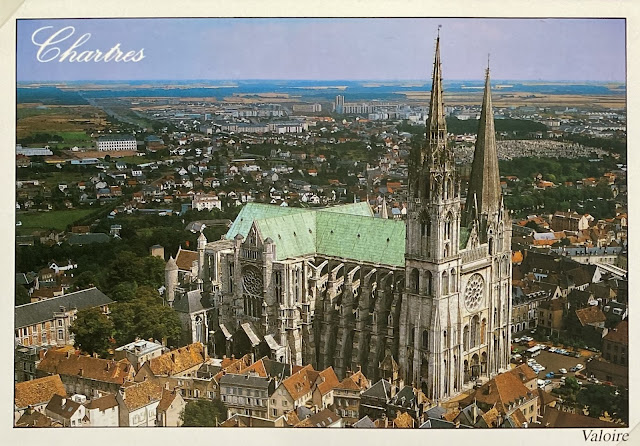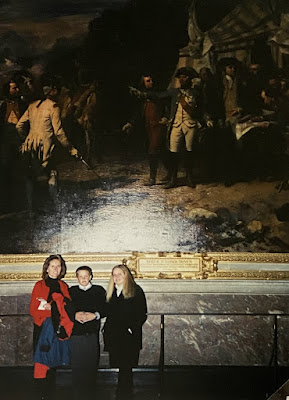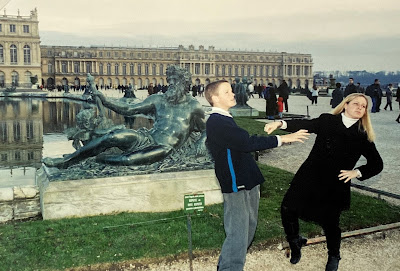December 24, 2000
It was Christmas Eve AND Sunday and we were not sure what would be open, but we began our day by driving to Chartres to see its massive Gothic cathedral, built mostly between 1193 and 1250 and with additions as recent as the 17th century. Considered to be one of the most beautiful cathedrals in Europe, it was added to the UNESCO World Heritage Sites in 1979.
The story is told that during World War II, the city itself was heavily bombed in August 1944. An order was given to destroy the cathedral as it was thought to be in use by the Germans as an observation post. An American army officer named Colonel Welborn Barton Griffith, Jr., challenged the order, volunteering to go behind enemy lines to investigate. He entered the cathedral and after searching it from the crypt to the bell tower, declared it free of Germans by ringing the bell and waving an American flag from the tower. The cathedral was spared. Tragically, Colonel Griffith was killed in action later on that day a few miles north of the city. Posthumous medals and awards from both the US and France are not enough to recognize his bravery and foresight. (Photo from Wikipedia)Unlike many of the other cathedrals of Europe, the stained glass windows also survived the war. When the war started in 1939, master glass artisans dismantled hundreds of the precious stained glass windows, and with the help of local volunteers, packaged the windows in crates and stored them in the crypt. Just before German invaders reached the area, the French people hauled them across the country to be stored in an underground quarry. In August 1944, bombs blew out the cathedral's temporary windows.
The cathedral is massive--430 feet long and 151 feet wide with a nave height of 121 feet. It covers 117,060 square feet. The two towers are 344 and 371 feet.
From Chartes we drove to Le Pecq, where our daughter had spent the last six months, to meet her host family. I can't believe we didn't take ANY pictures! My strongest memory is of the grandfather, a rather gruff elderly man, telling us that they were very grateful for the invading American forces in 1944 because France would have been lost without them. We had felt the scorn of the French for American tourists a few times on the trip, and his words were kind and comforting. I also remember that my daughter's love for cooking was stoked by her host mom, who taught her how to cook several French dishes.
We also attended the LDS ward in Versailles where our daughter had been going to church. It turned out that one of the members of the bishopric was from Bob's ward when he was growing up! Small world. The service was in French, so Rachael sat on one end of our group and translated while a missionary sat on the other end and translated. It was fun to experience that with her.
After church, we headed to the Palace of Versailles, built by King Louis XIV between 1661 and 1715. In 1682, King Louis moved his government to Versailles, essentially making it the capital of France, which lasted through the next two kings until 1789. The palace and its grounds are a UNESCO World Heritage Site.
 |
| Photo from Wikipedia |
It was our first experience with a full-blown mass, complete with a swinging incense burner (called a thurible), which was almost more than my smell-sensitive family could deal with. I remember that the organist was quite fantastic, but there was a key on the organ that kept sticking, which totally ruined his virtuosity. We sat near the back and slipped out when communion began.
READING
I have not yet read this book, but I was so intrigued by the story of how the cathedral was spared during World War II that I went online looking for a book that would tell me more about it. This one looks terrific! I've ordered a used copy. I'll be back with a review after I've read it.

_at_West_Point_in_1925.png)





























Despite this being over 23 years ago I remember quite a bit about this day. Versailles, of course, is amazing and midnight mass may be the first Catholic mass I've ever been to - I was quite taken by the swinging incense. Chartres Cathedral was impressive and the night's meal from cold Chinese takeout is something never to be forgotten. It reminds me of the Christmas movie where they go out for Chinese food on Christmas Day. I'm glad you're going back and covering this old trip.
ReplyDelete